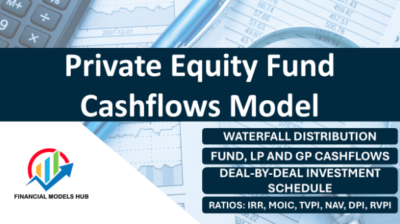Private equity investments offer unique opportunities for portfolio diversification, but they also require a deep understanding of various financial models, cash flow management, and investment strategies. By examining the intricacies of private equity cash flows, the importance of cash flow forecasting, and effective portfolio diversification, investors can optimize their investment outcomes in this high-stakes arena. We have also built a Private Equity Cash Flow Model Template which is being used by PE funds to model out their investment cash flows through to GPs and LPs via an American Waterfall and European Waterfall distribution structure.

Understanding Private Equity Cash Flows
Private equity cash flows differ significantly from traditional investment avenues. Unlike public securities, where funds are invested and liquidated at will, private equity involves a phased approach. Investors commit capital upfront, responding to capital calls from General Partners (GPs) as needed to purchase company stakes. This gradual capital infusion — a concept detailed in the Private Equity Pacing Model — ensures that funds are deployed efficiently over time.
The distributions back to investors occur through a structured plan, impacting the cash flow model forecasting. This dynamic is vividly captured in resources like the Cash Flow Model Forecasting, explaining how to manage liquidity through predictive modeling and future cashflows planning.
The Role of the Waterfall Cash Flow Distributions
Waterfall cash flow distributions are pivotal in private equity investments, defining how returns are allocated among investors and GPs. This economic structure of equity investments, illustrated by CalPERS, dictates the sequence and priority of returns, balancing risk and reward for vested parties.
Navigating the Equity Return Profile
The equity return profile in private equity is often characterized by the J-Curve effect, where initial investment returns may dip before increasing as companies grow. This fluctuation emphasizes the importance of understanding the return profile (the J-Curve) and strategically timing entries and exits.
Effective capital contribution management aligns with a smoother J-Curve, a principle echoed in the Private Equity Fund Cashflows Model, which details year-by-year fund performance.
Portfolio Diversification and Risk Management
Private equity investments can enhance portfolio diversification. By integrating uncorrelated assets like those described in Moonfare’s insights, investors can reduce overall risk and gain exposure to diversified growth avenues. Despite the illiquid nature of private equity, strategic planning through tools such as the NAVs forecasting ensures that investment stakes management aligns with broader financial goals.
Frequently Asked Questions
Q1: What are capital calls in private equity?
A1: Capital calls are requests from fund managers to investors for a portion of committed capital when funds are needed to secure investment opportunities.
Q2: How does the J-Curve affect my investment returns?
A2: The J-Curve represents the typical investment value path over time in private equity, where initial values may drop before increasing as the portfolio companies mature and grow.
Q3: How can private equity enhance my portfolio diversification?
A3: By adding private equity investments, which are often uncorrelated with public markets, you can reduce overall volatility and enhance potential returns.
Final Thoughts!
Mastering private equity investments involves a comprehensive understanding of intricate financial mechanisms, such as cash flow forecasting and the economic structure of equity funds. For effective capital calls, strategic waterfall distributions, and future cashflows planning, leveraging detailed models and resources is crucial. By embracing these components, investors can maximize their ROI while safely navigating the complexities of private equity.



